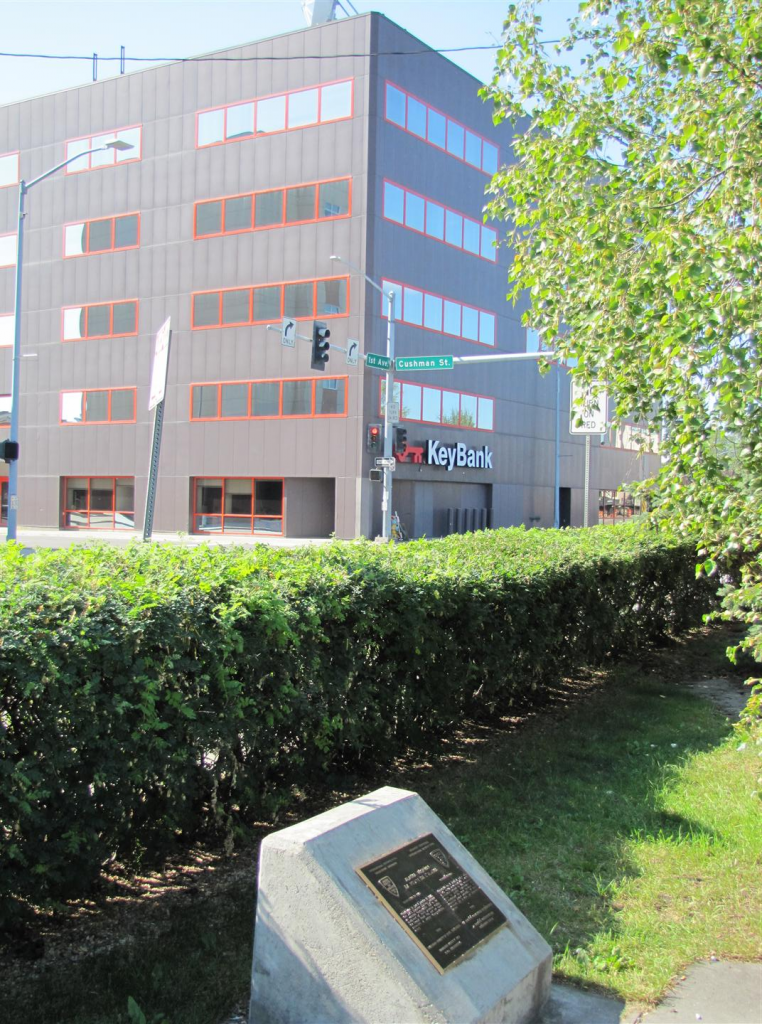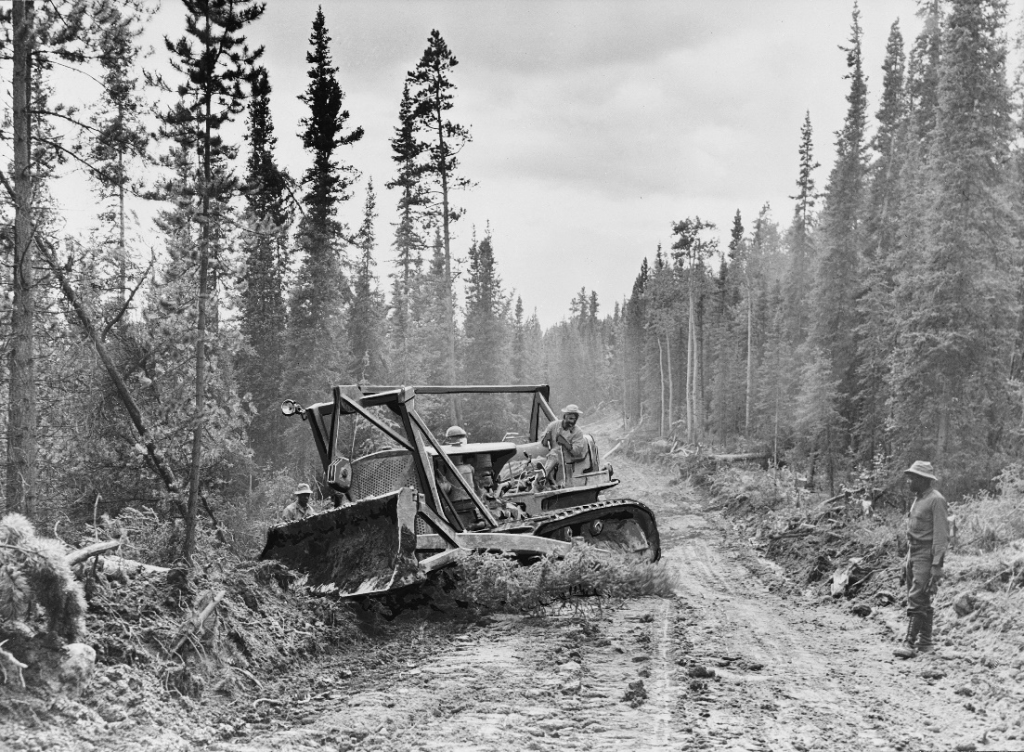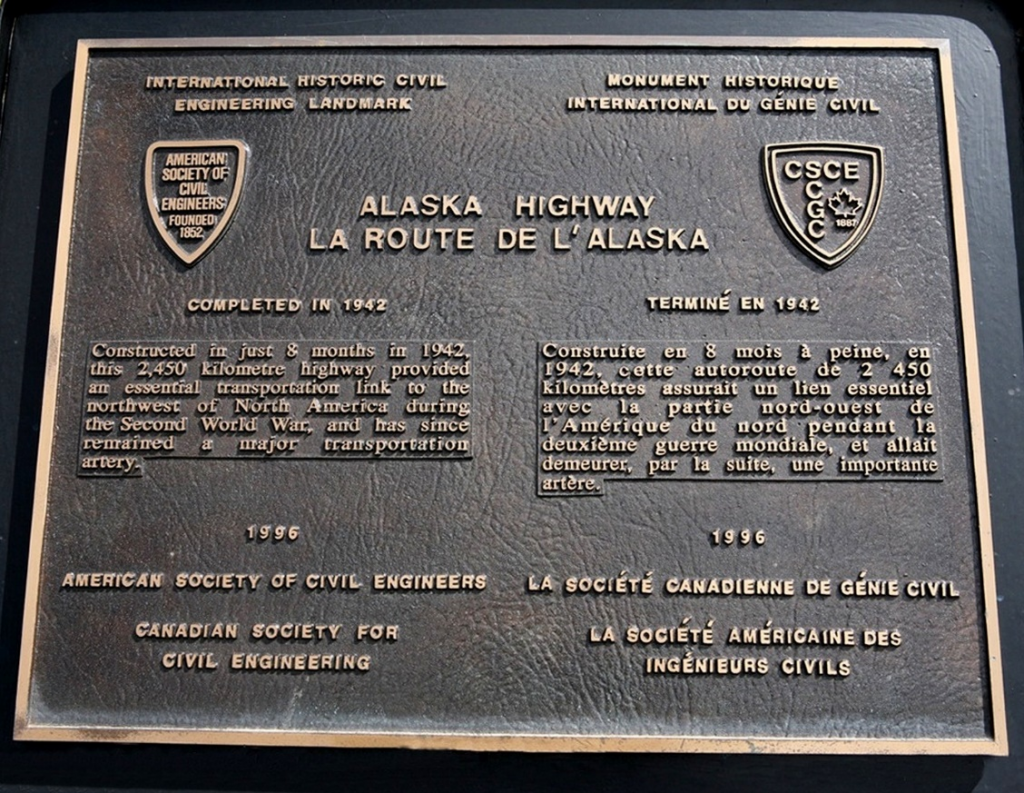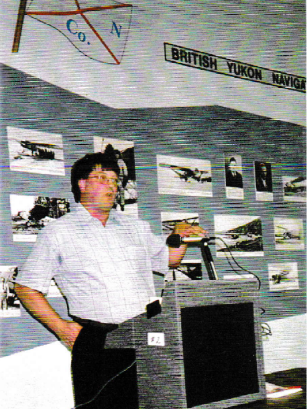
Plaque Locations: There are three commemorative plaques: in Dawson Creek, BC; Whitehorse, YT; and, Fairbanks, AK.
Dawson Creek, BC: Lat.: 55° – 45’ – 33” N.; Long.: 120° – 13’ – 31” W. (GPS: 55.7592078,-120.2252832). The plaque is mounted on a pedestal in Railway Park at Mile 0 of the Alaska Highway, Dawson Creek.

Whitehorse, YT: Lat.: 60° – 42’ – 43” N.; Long.: 135° – 4’ – 48” W. (GPS: 60.7118917, -135.0800172). The plaque is mounted on large rock just left of the entrance to the Yukon Transportation Museum at 30 Electra Drive, Whitehorse. From the Erik Nielsen Whitehorse International Airport, head south for 0.2 km on Barkley Grow Crescent. Turn left (south) on Kingbird Road, after 50 m turn right (west) to remain on Kingbird Road. Proceed 150 m to the museum on your right.

Fairbanks, AK: Lat.: 64° – 50’ – 38” N.; Long.: 147° – 43’ – 16” W. (GPS: 64.843966, -147.721087). The plaque is mounted on concrete plinth on the east side of Cushman Street, between 1st Ave and the Chena River. From AK Highway 2 westbound, turn left (west) onto Airport Way and, after 0.6 km, turn right (north) onto Cushman Street. Proceed 0.8 km to the park, on the left, just before crossing the river.

Description: The 2432 km (1520 mi.) Alaska (or ALCAN) Highway was constructed in 1942 to connect Dawson Creek, BC to Delta Junction, AK, via Whitehorse YT. The 155 km (96 mi.) Richardson Highway connects Delta Junction to Fairbanks.
Various schemes promoted since 1920 to connect Alaska and Yukon to southern Canada and the United States lacked the necessary political support until the Japanese bombed Pearl Harbour on December 7, 1941. The United States then quickly mobilized to build the highway, using the US Army Corps of Engineers to construct the pioneer road and civilian contractors under the direction of the US Public Roads Administration (PRA) to complete the final alignment.
Since the route passed through Canada, the Canadian Government gave permission for the route there and allowed the entry of the US military personnel and civilians needed to build it. Colonel William M. Hoge, the regional commander of the US Army Corps of Engineers, was assigned the daunting task of locating and building the pioneer road and PRA’s Thomas H. MacDonald managed its four primary contractors, R. Melville Smith (from Ontario, Canada), Okes Construction (St. Paul, Minnesota, USA), Dowell Construction (Seattle, Washington, USA) and C. F. Lytle and Green Construction (Souix City, Iowa, USA). As many as 10,000 Americans and 3,700 Canadians were employed at the peak season in 1942.
As had been previously agreed, the Canadian portion was turned over to Canada after the end of the war, on April 1, 1946. The road has since been widened and straightened.


Historic Significance: The three main purposes of the highway were to provide overland access: to Alaska, in the event of an invasion by Japan; to support of the Northwest Staging Route airfields between Edmonton AB and Fairbanks AK, which provided supplies and aircraft to the Russian Front; and, to support construction of the Canol Pipeline. General James A. O’Conner, Commander of the U.S. Army’s Northwest Service Command, stated “The primary purpose of this road was the airfields. The secondary purpose was to have an additional route to Alaska. Our sole aim has been to give a road that would serve the military purpose and not have a peacetime road.”
The route of the Alaska Highway was extremely rugged, passing through largely unmapped territory and over five mountain ranges. Significant experience was gained in Arctic engineering and construction, particularly in permafrost. Construction was extremely rapid, taking only 8 months, and expensive: at the end of construction the final cost was calculated, by the PRA, at US$ 41,350/km (US$ 66,160/mi.).
About one third of the American workers were black soldiers, members of three newly formed "Negro regiments".

Plaque Wording: International Historic Civil Engineering Landmark. ASCE CSCE. ALASKA HIGHWAY. Completed in 1942. Constructed in just 8 months in 1942, this 2,450 kilometre highway provided an essential transportation link to the northwest of North America during the Second World War, and has since remained a major transportation artery. 1996. American Society of Civil Engineers. Canadian Society for Civil Engineering.
Monument Historique International du Génie Civil. ASCE SCGC. LA ROUTE DE L’ALASKA. Terminé en 1942. Construite en 8 mois à peine, en 1942, cette autoroute de 2 450 kilomètres assurait un lien essentiel avec la partie nord-ouest de l’Amérique du nord pendant la deuxième guerre mondiale, et allait demeurer, par la suite, une importante artère. 1996. La Société canadienne de genie civil. La Société américaine des ingénieurs civils.
Plaque Unveiling Ceremonies: Three plaques were unveiled with individual ceremonies in Dawson Creek, Whitehorse and Fairbanks. The first public unveiling of the plaque occurred at the CSCE Annual Conference in Edmonton in June 1996.
The plaque at Whitehorse was unveiled on July 12, 1997. The dignitaries present were: Ken Johnson, representing the CSCE; Louise Hardy, MP for Yukon; Piers McDonald, Government Leader of Yukon; and, Barb Harris, Whitehorse Councillor. Ken Coates presented a heritage lecture on the Alaska Highway.

Whitehorse plaque unveiling, from left, Ken Johnson, Louise Hardy, Barb Harris, Piers McDonald, Ken Coates, and Constable Al Lucier. (Source: K. Johnson)

Links to Online Documentation:
Ken Johnson 1996 paper on Alaska Highway
Historynet article and video on Alaska Highway Construction
Katherine Koller 2016 article on Alaska Highway Construction
Yukon Archives 2007 webpage on role of Black workers building Alaska Highway